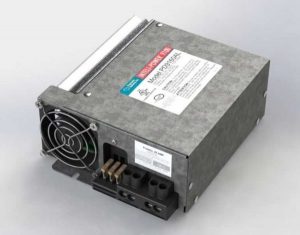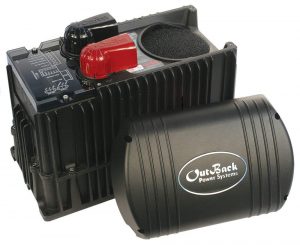No matter how much solar you have, sometimes you need to plug in to either shore power or a generator to charge up your batteries. There’s only a couple major things to look for when picking a traditional battery charger.
Customized for Lithium?
Has your charger been set up for charging lithium batteries or traditional lead-acid batteries? If it has, or it can be adjusted manually, then great, you’re good to go. If not, you’ll get mediocre charge performance at best, and at worst, it could try to send voltages too high for your batteries to accept and then you just have to hope the internal BMS in your battery does its job.
Charging speed / # of amps
Most battery chargers list how many amps (on a 12-volt nominal scale) they can put into the battery. They will sometimes also include their power conversion efficiency, but not always. Generally, the more amps the better, but there’s a few situations where you might not want to draw that much power.
If you’re running a typical setup where a generator is used to charge your batteries, and that’s the only job the generator is doing, then go ahead and get the biggest charger you reasonably can. By doing so, you’ll have to run the generator for less time, and everyone’s happy about that.
But, if you are running other equipment alongside the generator (such as an air conditioner, for example), then it might make sense to have a lower-power charger since the gennie might not be able to power both items at the same time if they’re both running at full load.
Another option to consider is if you’re going to be moochdocking or staying in parks frequently. If you’re moochdocking and trying to not draw a lot of power from your friend’s 15-amp outlet (with who-knows-what) also on the same circuit, it makes sense to have a smaller charger to help live peacefully with whatever else is going on. If you’re going to be staying in parks frequently, a lower power charger will be plenty to handle your regular charging since you’ll have shore power and can stay plugged in overnight or over multiple days.
Dedicated Charger or Combination Inverter/Charger
There are pros and cons to having either a dedicated charger or an Inverter/Charger combo unit. The dedicated charger is a less expensive piece of equipment and can be easily replaced if it fails. You also have the choice of what size charger you’d like. The Inverter/Charger combo means you’ll have less equipment in your electronics bay, and many can handle the switchover to shore power automatically for you. Some, particularly hybrid units, will let you set exactly how much power to tap off the shore power or generator source, and that can offer a lot of flexibility. These combo units, particularly the hybrid kind, can get very expensive though, and it they fail, you’re out both your inverter and charger.
Progressive Dynamics 30-amp
Amps: 30
Cost: $201
Link: BattleBorn
This is a good choice for low-power situations where you don’t want to draw a lot of current from your source supply. Already tuned for Lithium Batteries, this is easy to drop in and start using.
Progressive Dynamics 60-amp
Amps: 60
Cost: $268
Link: BattleBorn
This is the highest-amperage charger that BattleBorn has available that doesn’t require a special 20-amp cord. Great option for anyone that wants to charge up their batteries quickly. I would recommend this charger for most people.
Victron
Amps: 120
Cost: ~$1400 + remote control panel
Link: Continuous Resources
This 3000-watt inverter/charger will handle most full-timer’s needs quite well. Accessories such as control panels and remote monitoring can get a bit expensive, but this sturdy unit will take care of you over the years.
Magnum Hybrid Inverter/Charger
Amps: 125
Cost: ~$1350 + remote control panel
Link: Amazon
This hybrid inverter/charger will provide some serious power to your battery bank, assuming you have a 30-amp shore power connection. Or, if you’re using a small generator, you can change the charging parameters to play nicely with that small generator. These kinds of units give lots of flexibility. (Note: the remote control panel is required to setup lithium charging and change charge input conditions.)
Outback Inverter/Charger
Amps: 125
Cost: ~$1,800 + remote control panel
Link: Amazon
This hybrid inverter/charger will provide some serious power to your battery bank, assuming you have a 30-amp shore power connection. Or, if you’re using a small generator, you can change the charging parameters to play nicely with that small generator. These kinds of units give lots of flexibility. (Note: the remote control panel is required to setup lithium charging and change charge input conditions.)




